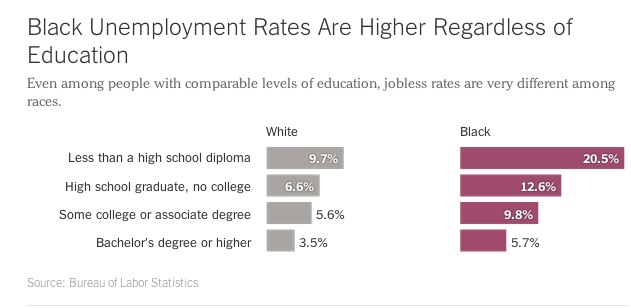Five Decades Past the Era of Legal Segregation Black Unemployment Remains Double the Rate for Whites
/
Economic Powerlessness means Political Powerlessness.Five decades past the era of legal segregation, a chasm remains between black and white Americans – and in some important respects it’s as wide as ever. Through economic booms and busts, the unemployment rate has been persistently higher for African-Americans than for whites across the decades.
From [HERE] and [HERE] The US unemployment rate fell to its lowest level since 2008 on Friday, in a move hailed as a sign of progress by economists despite 9 million people remaining out of work. The Bureau of Labor Statistics (BLS) said that the unemployment rate fell to 5.8%, as employers added 214,000 jobs in October. The average monthly gain in the past year was 222,000 . The industries that added the most jobs were “food services and drinking places, retail trade, and health care” the BLS said.
The National Women’s Law Center objected that most of the gains were jobs gains were in low-paying minimum-wage jobs.
“Although job growth continued last month, it’s troubling that half of the 214,000 jobs added were low-wage. The largest job gains were in the restaurant industry, where most of the workforce relies on tips—and the federal minimum cash wage is just $2.13 an hour. Finding a job that pays poverty-level wages doesn’t feel like a recovery,” the NWLC said. Dr. Blynd calls these jobs, "Mcjobs."
Joblessness also shows stark differences by ethnic group. The black unemployment rate, at 10.9%, is more than double the white unemployment rate of 4.8% or 2.27 times higher.

This racial unemployment gap is virtually unchanged over the last 40 years. The income and wealth gaps have actually widened. So has the gap in educational attainment between Blacks and whites.
The gap is not even narrowing in a meaningful way. Instead, the ratio of the unemployment rate among blacks versus that among whites has been amazingly consistent — between 2 and 2.5 – for the 40 years that official data go back. In 1972, the jobless rate among African-Americans was 2.04 times that among whites. In 2013, the ratio was 2.02. The graphs below and above are from a 8/13/14 NY Times article, "America’s Racial Divide, Charted." This disparity is caused by the operating system of white supremacy/racism.

How much of this is caused by differing educational levels of black workers versus white workers, given that people with advanced education have sharply lower jobless rates than those without? Only some of it is.
Even among people with similar levels of education, the black unemployment rate is higher. There was a 5.7 percent unemployment rate among African-Americans with a bachelor’s degree or higher in 2013, compared with 3.5 percent among white Americans with a bachelor’s degree or higher. Indeed, joblessness is higher among blacks in every education level tracked by the Labor Department.

Moreover, while the proportion of blacks getting a college degree has risen sharply over the last generation, the proportion of whites doing the same has risen even more.
According to census data analyzed by two Harvard economists, Claudia Goldin and Lawrence Katz, 21 percent of black 30-year-olds had a college degree in 2012, compared with 38 percent of white 30-year-olds. The 17 percentage point gap between those two numbers is considerably wider than the 10 percentage point gap in 1970.

There is better news to be seen in the types of jobs workers of different races are doing. A rising proportion of the nation’s white-collar professionals are African-American. Some 7.4 percent of managers and executives were black in 2013, up from 5.7 percent in 1990, and the ratio of professionals like lawyers and engineers who are black had risen to 9.3 from 6.7 percent.

Still, blacks are underrepresented in these jobs, and overrepresented in low-skilled jobs. That might be one reason why the rise of a black professional class has not been sufficient to reduce the overall income gap between white and black workers. That gap, if anything, is widening. In 1983, the median weekly pay of white workers was 18.4 percent higher than that of black workers. Three decades later, the premium had risen to 21.6 percent.

The differences in levels of wealth are even more striking. For two people with similar incomes, the level of wealth they accumulate can vary widely, depending on whether they received an inheritance or other help from parents; whether they had to take on student debts or other loans, and how aggressively they save and invest, among other factors.
And this gap has widened during the last recession and the slow recovery since then, according to an analysis of Federal Reserve data by the Urban Institute. The researchers found that white families were 4.3 times as wealthy as black and Hispanic families in 2007. By 2010, the multiple had widened to 6.1. [MORE]









































































































































































































































































